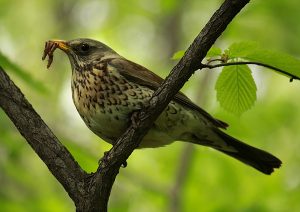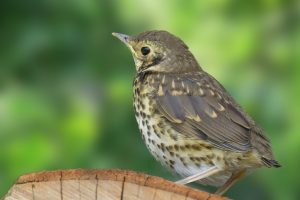In Britain, we are lucky enough to have three resident members of the thrush family; the blackbird, mistle thrush, and the song thrush.
Some species of garden bird choose to leave our shores in the autumn, in search of a warmer climate. Do thrushes migrate, I wondered, and if so, do all species behave in the same way?

Thrushes are migratory and resident. Some choose to stay throughout winter and form a new territory while others head south in the hope of winter sun and plentiful food supplies.
Scandinavian thrushes head to the UK in September as their winter is much harsher than ours.
Each branch of the thrush family behaves differently.
Table of Contents
Mistle thrush
The mistle thrush is slightly bigger than the song thrush, which may be a determining factor into their reasoning to winter at home.
Almost all mistle thrushes are sedentary; a tiny amount of ringed birds have made it to Ireland or France, but only when we have suffered a particularly harsh winter.
Instead, the birds choose to form new territories of pairs and family groups. They most often settle around a healthy berry tree such as pyracantha or rowan.
Scandinavian and northern European mistle thrushes are extremely migratory. Most bypass the UK on their way to much warmer climates, such as Morocco, Iberia, and the Mediterranean basin. Of the limited few that remain, they tend to stay on the east coast, where they first landed.
Song thrush
The song thrush is the smallest of the thrush family and probably the one we’re most used to seeing. Their speckled chest and the loud song is most familiar, even during winter.
Most of the birds are permanent residents within the UK. Not all choose to stay; some song thrushes show signs of seasonal movement and head to Ireland or France.
The swell in numbers of song thrush during winter is due to Dutch and Belgian birds that choose Britain to winter. Finnish birds are also known to have wintered here. However, the majority of their population will continue to France, where the climate is milder.
Blackbird
The blackbird is the most sedentary of the thrush family, although a limited few of their population might head to southern Europe in autumn.
Most remain in the UK and spend the cold months moving around on the hunt for fruit, berry, and nut crops.
Immigrant thrushes
The redwing is a cousin of the British thrush family that lives in Scandinavia and Iceland.
They are the smallest of all thrushes and recognisable by the white stripe over their eye and red tinge beneath their wings.
Of the redwings that choose to winter in the UK, it is the Scandinavian ones that head to the south of England. The Icelandic birds head to Scotland and Ireland to nest and search for food.
They arrive in late September and begin their journey home around March, sometimes as late as April.

The Fieldfare is one of the bigger thrushes. They too come from Scandinavia in their droves. They begin arriving in October; there might be as many as 750,000 of them.
They fly and gather in large flocks, particularly on open fields, farmland, and uplands.
They have a passion for the berries of the rowan tree and will nest in territories as near to them as possible.
Some begin their journey home in March while others choose to stay as late as May.
Final thoughts
It would seem that most British thrushes are happy with their lot and winter in the UK.
European thrushes can’t wait to escape their harsh winters, finding the conditions here much more acceptable.
Coming up with an answer for ‘do thrushes migrate’ isn’t as clear cut as you might think.
Most don’t; a few do unless they’re northern European. In that case, thrushes definitely do migrate!
